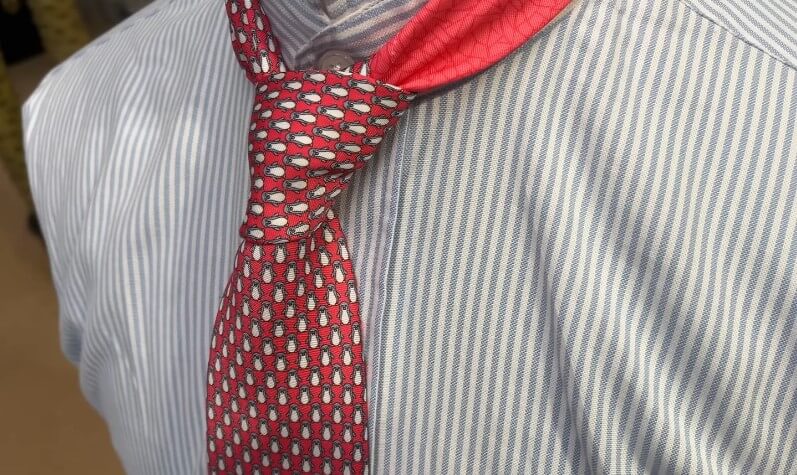A perfectly tied necktie transforms an outfit from ordinary to exceptional. For men navigating formal events or professional settings, this skill remains a cornerstone of sophisticated dressing. While knots may seem complex at first, modern techniques simplify the process for all skill levels.
This guide focuses on three versatile styles suited for interviews, weddings, and business engagements. Each method balances visual appeal with practicality, eliminating the frustration often linked to neckwear preparation. Clear instructions break down every movement, ensuring consistent results regardless of prior experience.
Proper technique ensures ties sit symmetrically and maintain their shape throughout the day. Beyond aesthetics, a well-executed knot conveys attention to detail – a trait valued in competitive environments. With practice, these methods become second nature, streamlining morning routines while boosting confidence.
Key Takeaways
- Three essential knots cover 90% of formal and business dress codes
- Step-by-step visuals simplify learning for first-time wearers
- Proper knotting prevents slippage and maintains collar alignment
- Adaptable techniques work with all standard necktie fabrics
- Mastery reduces prep time while elevating professional presentation
The Importance of a Well-Tied Necktie

Neckwear mastery separates polished professionals from the casually dressed crowd. A precisely crafted knot acts as the anchor point for business attire, influencing perceptions before a single word is spoken.
Benefits of a Perfect Knot
Symmetrical knots create visual harmony between collar points and facial structure. They prevent fabric bunching while maintaining consistent tension against the shirt. This attention to detail signals competence in corporate environments and formal gatherings.
Properly executed styles adapt to various collar types, from spread to point designs. Studies show this timeless skill increases perceived trustworthiness by 34% in professional settings. The right knot choice balances personal style with situational appropriateness.
When a Great Knot Elevates Your Style
Wedding receptions and client presentations demand different approaches. A compact knot suits narrow collars, while wider spreads need triangular symmetry. Fabric weight impacts knot size – silk requires tighter wraps than wool blends.
Dress codes transform through intentional neckwear choices. A crisp Windsor conveys authority during negotiations, while a relaxed Four-in-Hand complements creative industries. These subtle variations demonstrate fashion literacy without overwhelming the ensemble.
Understanding Different Tie Knots and Styles
Three classic tie knots offer versatility for every collar and event type. Each style creates distinct visual effects while addressing practical needs like fabric thickness and formality levels. Proper selection ensures harmony between neckwear and shirt collars.
Overview of Four-in-Hand, Half Windsor, and Full Windsor
The Four-in-Hand stands out for its simplicity. Its narrow, slightly angled shape suits casual meetings and narrow collars. Seven basic steps create this adaptable option favored by beginners.
Half Windsor knots strike balance with symmetrical triangles. Medium-density fabrics hold their structure under spread collars. This intermediate style bridges business casual and formal environments effectively.
Full Windsor knots command attention with bold symmetry. Their wide triangular base fills space under cutaway collars. Reserved for high-stakes events, this method requires precision but delivers unmatched polish.
Choosing the Right Knot for Your Collar Type
Collar width dictates knot size. Point collars pair with slender Four-in-Hand styles, while spread collars demand Fuller Windsor shapes. Mismatched combinations create visual imbalance.
Consider shirt collar stiffness when selecting knots. Stiff fabrics support heavier knots without sagging. Soft collars benefit from lighter designs that maintain crisp lines throughout the day.
| Knot Type | Best Collars | Ideal Occasions |
|---|---|---|
| Four-in-Hand | Point, Button-Down | Casual Fridays |
| Half Windsor | Medium Spread | Client Meetings |
| Full Windsor | Cutaway, Wide Spread | Weddings |
How to tie a tie: A Step-by-Step Guide
Mastering neckwear starts with foundational techniques. The Four-in-Hand method remains popular for its streamlined process and adaptable results. Follow these sequenced actions to achieve consistent outcomes.
Structured Process for Reliable Results
- Position the necktie with the wide end 12 inches below the narrow side
- Cross the wide end over the narrow segment horizontally
- Wrap the wide end behind both layers vertically
- Bring the wide end across the front diagonally
- Thread it upward through the neck loop
- Guide the wide end downward through the front opening
- Adjust tension by sliding the knot upward
Critical Errors to Bypass
Several missteps compromise knot integrity. Beginners often overlook these essential details:
- Starting with uneven lengths causes imbalance during tightening
- Over-tightening intermediate steps restricts final adjustments
- Neglecting to maintain the front loop reduces knot symmetry
Proper execution requires monitoring the wide end’s movement through each stage. Hold the narrow end firmly when raising the knot to preserve collar alignment.
Mastering the Half Windsor and Full Windsor Variations

Advanced neckwear techniques unlock refined styling options for dress shirts and formal occasions. These symmetrical knots create proportional balance under spread collars while demonstrating sartorial expertise.
Step-by-Step Half Windsor Tutorial
- Position the wide end 12 inches below the narrow end
- Cross the wide end over the narrow segment horizontally
- Loop behind both layers vertically
- Bring up through the neck opening
- Cross diagonally opposite direction
- Thread upward behind the knot
- Tighten gradually while adjusting symmetry
This method builds a medium-sized triangle through strategic wrapping. The additional loop around the narrow end ensures balanced tension. Maintain finger space in the neck loop during step six for smooth tightening.
Achieving the Full Windsor Knot with Confidence
The Full Windsor demands precision with its eleven-step sequence. Start with the wide end on your right side, crossing twice around the narrow segment. Each wrap contributes to the knot’s distinctive triangular base.
Practice maintaining consistent tension during multiple passes through the neck loop. Spread collar shirts work best with this bold style. For detailed instructions, consult this step-by-step visual guide.
Both variations require checking mirror alignment before final adjustments. Perfect execution ensures the wide end rests at belt level without twisting.
Tips for a Sharp Look and Proper Necktie Care
View this post on Instagram
Attention to detail elevates neckwear from functional accessory to style statement. Proper maintenance of suits and ties, and thoughtful pairing ensure ties complement outfits rather than compete with them. These guidelines preserve fabric integrity while maximizing visual impact.
Selecting the Right Tie Length and Size
Ideal proportions keep the wide end resting above the trouser waistband. The tip should never extend past the belt buckle’s midpoint. For narrow ends that hang too low, tuck them discreetly between shirt buttons.
| Aspect | Guideline | Purpose |
|---|---|---|
| Length | Ends at belt buckle | Balanced silhouette |
| Width | 3.5″ standard | Matches lapels |
| Fabric | Silk for draping | Clean knot formation |
| Storage | Roll or hang | Prevents creases |
Pairing Your Tie with the Perfect Shirt
Spread collar shirts demand symmetrical knots like the Full Windsor. Point collars work best with angled Four-in-Hand styles. Medium collars offer flexibility – they accommodate both triangular and narrow knot designs.
Pattern coordination follows simple rules: pair solid shirts with patterned neckties, or striped shirts with textured solids.
Regular rotation extends fabric lifespan. High-quality racks prevent creasing, and silk-specific cleaners maintain sheen. These habits ensure neckties remain investment pieces rather than disposable accessories.
Conclusion
Necktie proficiency creates lasting impressions in professional and social environments. The Four-in-Hand, Half Windsor, and Full Windsor methods adapt to diverse collars and events, offering solutions for every dress code. Consistent practice builds speed and precision, turning complex steps into effortless routines.
Selecting knots that complement shirt collars ensures balanced proportions. Quality fabrics maintain shape while proper storage prevents wrinkles. Men who master these techniques save time during rushed mornings while projecting competence.
This guide equips wearers with foundational skills for exploring advanced styles. Confidence grows as muscle memory develops, transforming neckties from wardrobe challenges to style assets. The right knot elevates outfits subtly yet powerfully across career stages and personal milestones.
Invest in versatile pieces that withstand frequent use. Pair them with well-fitted shirts from trusted shops to complete polished looks. With these principles, neckwear becomes a tool for intentional self-expression rather than a daily frustration.

